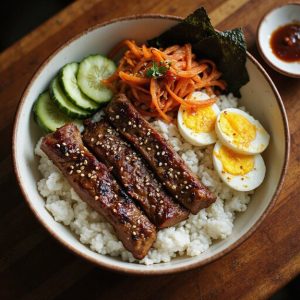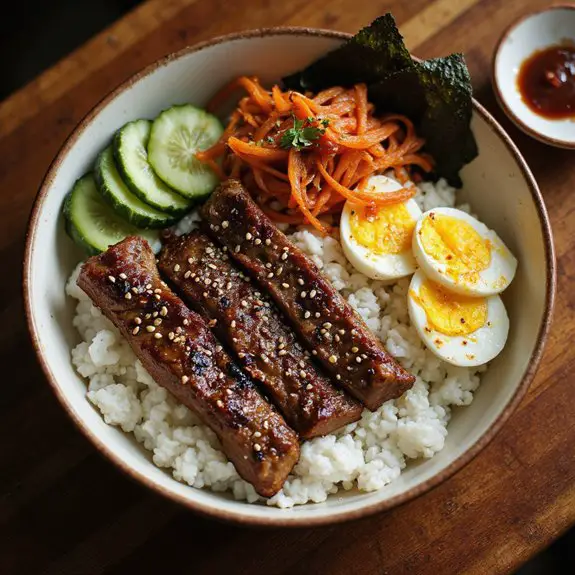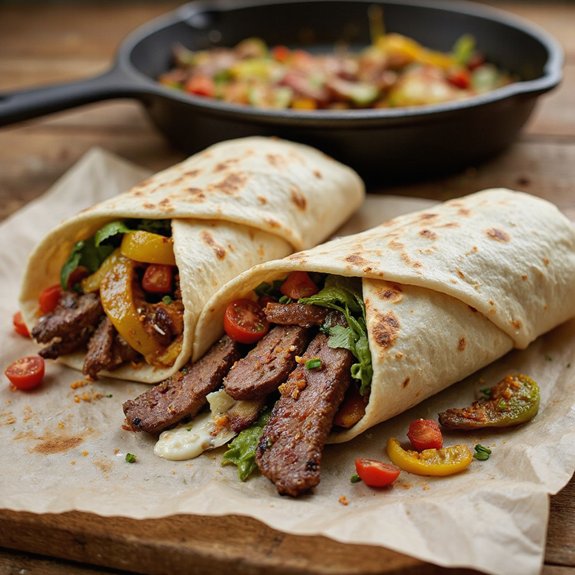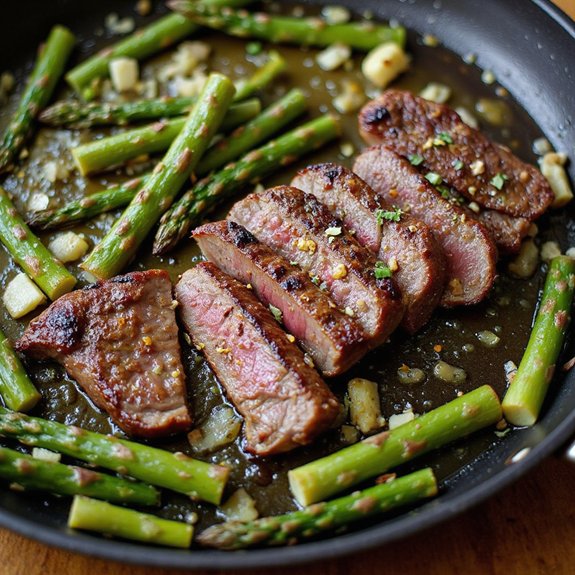Picture yourself savoring a beautifully arranged Korean Bento Box, with its vibrant colors and enticing aromas.
This delightful meal is a demonstration of how simple ingredients can create a cozy and satisfying experience.
As the beef sizzles in the skillet and the rice steams to perfection, each component transforms into a harmonious symphony of flavors.
Let’s bring this delicious Korean Bento Box to life and enjoy the warmth and comfort it offers.
Kitchen Tools Required
- 1 Rice cooker
- 1 Large skillet
- 1 Medium pot
- 1 Cutting board
- 1 Knife
- 1 Mixing bowl
- 1 Spatula
- 4 Bento boxes
Ingredients
- 2 cups rice, short-grain
- 1 lb beef, sliced thinly
- 4 tablespoons soy sauce
- 2 tablespoons sugar, brown
- 2 tablespoons sesame oil
- 2 cloves garlic, minced
- 1 teaspoon ginger, grated
- 1 cup kimchi
- 2 eggs
- 1 cucumber, sliced
- 1 carrot, julienned
- 1 tablespoon sesame seeds, toasted
- 4 sheets seaweed, nori
- 1 tablespoon gochujang, optional
Cook & Prep Time
To efficiently manage your time while preparing the Korean Bento Box, follow this timeline:
- Preparation (30 minutes):
- Reading & Gathering Ingredients/Equipment (5 minutes):
- Read through the recipe to understand the steps.
- Gather all the necessary ingredients and equipment listed.
- Rice Preparation (5 minutes):
- Rinse the rice thoroughly.
- Marinating Beef (5 minutes):
- Combine beef, soy sauce, brown sugar, sesame oil, garlic, and ginger in a mixing bowl and set aside to marinate.
- Vegetable Prep (10 minutes):
- Slice the cucumber, julienne the carrot, and mince the garlic.
- Grate the ginger.
- Preparation of Additional Elements (5 minutes):
- Prepare the seaweed strips and measure out sesame seeds.
- Cooking (20 minutes):
- Start Cooking Rice (0 minutes):
- Begin cooking the rice in the rice cooker according to the manufacturer’s instructions.
- Cooking Beef (7 minutes):
- Heat the skillet over medium-high heat and cook the marinated beef until fully cooked.
- Boiling Eggs (7 minutes):
- Simultaneously, boil the eggs in a medium pot.
- Assembly & Resting (10 minutes):
- Assembling Bento Boxes (10 minutes):
- Arrange cooked rice, beef, kimchi, sliced cucumber, julienned carrot, and boiled eggs in the bento boxes.
- Sprinkle sesame seeds and add nori strips.
- Add a dollop of gochujang if desired.
- Resting Time (10 minutes):
- Let the bento boxes rest for 10 minutes before serving to enhance flavor integration and maintain freshness.
This timeline guarantees you optimize your cooking process and adhere to the given times for preparation, cooking, and resting, resulting in a perfectly assembled Korean Bento Box.
Recipe Instructions
Rinse the rice thoroughly and cook it in the rice cooker according to the manufacturer’s instructions.
In a mixing bowl, combine beef, soy sauce, brown sugar, sesame oil, garlic, and ginger, then marinate for 15 minutes.
Heat the skillet over medium-high heat and cook the marinated beef until fully cooked, about 5-7 minutes.
Boil the eggs in a medium pot for 7 minutes, then peel and slice them in half.
Arrange the cooked rice, beef, kimchi, sliced cucumber, julienned carrot, and boiled eggs in the bento boxes.
Sprinkle sesame seeds over the beef and vegetables.
Cut the nori sheets into strips and add them to the bento boxes.
If desired, add a dollop of gochujang for extra spice.
Allow the bento boxes to rest for 10 minutes before serving.
Serving Tips
- Pickled Radish: Add a revitalizing tangy crunch to complement the savory beef.
- Miso Soup: Serve alongside the bento for a warm and comforting addition.
- Fruit Slices: Include a few slices of seasonal fruit for a sweet and fresh finish.
- Korean Pancakes (Pajeon): Pair with a side of these crispy pancakes for added variety.
- Kimchi Stew (Kimchi Jjigae): Enhance the meal with a hearty, spicy stew for those who love extra heat.
Storage
To store Korean Bento boxes, keep them in an airtight container in the refrigerator.
Consume within 2-3 days to guarantee freshness.
Reheat thoroughly before eating, especially the beef and rice.
Freezing
To freeze Korean Bento, separate components into airtight containers.
Avoid freezing fresh vegetables and nori as they lose texture.
Thaw in the fridge overnight before reheating the rice and beef.
Reheating
For reheating a Korean bento box, gently warm it in a microwave at medium power.
This helps avoid overcooking. Cover loosely to retain moisture.
This guarantees even heating throughout.
Final Thoughts
Creating a Korean Bento Box is a delightful way to enjoy a balanced and flavorful meal.
The combination of savory beef, tangy kimchi, and fresh vegetables offers a variety of tastes and textures.
By following the steps outlined, you can create a delicious and visually appealing bento box.
Feel free to customize the ingredients to suit your preferences.
Don’t forget to let the box cool slightly before sealing it to keep everything fresh.
Enjoy your homemade Korean Bento!
Frequently Asked Questions
Can I Substitute White Rice for Brown Rice in a Korean Bento?
You can swap white rice for brown rice in your bento. Brown rice brings a nutty aroma, chewy texture, and earthy taste. It adds a wholesome twist, enhancing the traditional flavors of the Korean bento experience.
What Are Some Vegetarian Alternatives for Beef in a Korean Bento?
You can replace beef with tofu, tempeh, or mushrooms for a vegetarian twist. Let the tofu soak in soy sauce and sesame oil, enhancing its flavor. Pair it with crisp veggies, and enjoy this harmonious Korean fusion.
How Do I Prevent the Bento Box From Becoming Soggy During Transportation?
To keep your bento box crisp, layer dried seaweed between rice and moist ingredients. Use airtight containers, letting the box cool before sealing. This preserves flavors and textures, ensuring a vibrant, fresh experience upon opening.
Can I Add Fruit to a Korean Bento for a Balanced Meal?
Yes, you can add fruit. Choose firm fruits like apples or grapes for freshness. Their crisp texture and sweet flavors complement savory components, offering a balanced, sensory delight. Just separate them to maintain their juicy integrity.
Is It Possible to Make a Korean Bento Box Spicy Without Using Gochujang?
Absolutely, you can add spice without gochujang. Try incorporating sliced chili peppers or a drizzle of spicy sesame oil. The heat will dance across your taste buds, offering a fiery contrast to the savory, umami-rich flavors.

Korean Bento Box
Equipment
- 1 Rice Cooker
- 1 large skillet
- 1 medium pot
- 1 Cutting board
- 1 Knife
- 1 Mixing bowl
- 1 Spatula
- 4 Bento boxes
Ingredients
- 2 cup rice short-grain
- 1 pound beef sliced thinly
- 4 tablespoon soy sauce
- 2 tablespoon sugar brown
- 2 tablespoon sesame oil
- 2 clove garlic minced
- 1 teaspoon ginger grated
- 1 cup kimchi
- 2 eggs
- 1 cucumber sliced
- 1 carrot julienned
- 1 tablespoon sesame seeds toasted
- 4 sheet seaweed nori
- 1 tablespoon gochujang optional
Instructions
- Rinse the rice thoroughly and cook it in the rice cooker according to the manufacturer’s instructions.
- In a mixing bowl, combine beef, soy sauce, brown sugar, sesame oil, garlic, and ginger, then marinate for 15 minutes.
- Heat the skillet over medium-high heat and cook the marinated beef until fully cooked, about 5-7 minutes.
- Boil the eggs in a medium pot for 7 minutes, then peel and slice them in half.
- Arrange the cooked rice, beef, kimchi, sliced cucumber, julienned carrot, and boiled eggs in the bento boxes.
- Sprinkle sesame seeds over the beef and vegetables.
- Cut the nori sheets into strips and add them to the bento boxes.
- If desired, add a dollop of gochujang for extra spice.
- Allow the bento boxes to rest for 10 minutes before serving.





